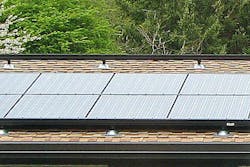Sustainable photonics celebrated by SPIE this Earth Day
Bellingham, WA--Among the achievements to celebrate on Earth Day, Monday 22 April, says SPIE, the international society for optics and photonics, are photonics applications that enhance sustainable living opportunities, enable monitoring of climate change and its environmental impacts, and solve many other environmental challenges. SPIE says that researchers in the field are happy to see the keen interest in "green" technologies on the part of young researchers.
Sustainable photonics are hard at work in the form of photovoltaics for generating energy from sunlight, solid-state lighting (SSL) for cheaper, more efficient and longer lasting light sources, sensors to detect ocean temperatures and monitor the effect on fish populations, and numerous other applications.
An annual conference on sustainable photonics held at SPIE Photonics West in San Francisco, CA highlights papers in which research in the field enables development of new technology that can improve standards of living and save money and resources. To emphasize the importance of this research, this year SPIE recognized four papers with Green Photonics Awards.
"Photonics innovations enable improved sustainable products and services worldwide. The winners of this year's Green Photonics Awards are exemplary in this regard," said Stephen Eglash, executive director of the Energy and Environment Affiliates Program at Stanford University, and founder and chair of the green photonics symposium. "Each of the winning papers provides new information to help solve existing problems using photonics."
Published award papers are available for free download in the SPIE Digital Library through 31 July; follow the links below.
Next-generation lighting
SSL, utilizing light-emitting diodes (LEDs) is the new industry standard for energy efficiency, and the rapid development of LEDs has flooded the lighting market, Eglash noted. LEDs are efficient and long-lived sources for general lighting, but commercially available products exhibit variable quality. Carsten Dam-Hansen and Technical Univ. of Denmark colleagues Anders Thorseth, Dennis Corell, and Peter Poulsen tested a large number of LED lamps to evaluate quality and lifetime, as reported in their paper "Light quality and efficiency of consumer grade solid state lighting products".
Cheaper solar power
High-efficiency solar cells are needed to decrease the cost of solar energy, Eglash said. Solar cells that use thin absorber layers cost less and require less of the Earth's materials. But inefficiencies of conventional light trapping techniques limit the ability to reduce the thickness of thin-film solar cells. In the first of two papers recognized in this area, "The photovoltaic potential of femtosecond-laser textured amorphous silicon" (PDF 379 kB), authors Meng-Ju Sher, Benjamin Franta, Kenneth Hammond, Lysander Christakis, and Eric Mazur of Harvard University told how they used femtosecond laser texturing to reduce reflection and enhance light absorption, enabling high efficiency from thin absorbers.
Clément Colin of the Lab. de Photonique et de Nanostructures, an author of the other winning paper in the category, explained that his team used "new light-trapping strategies for broadband absorption in ultra-thin solar cells. These results allow at least a tenfold thickness reduction of the absorber, and pave the way to novel architectures for thin-film and high-efficiency photovoltaic technologies." Colins’ co-authors for the paper "Broadband light trapping in ultra-thin nano-structured solar cells" are Inés Massiot,Andrea Cattoni, Nicolas Vandamme, Christophe Dupuis, Nathalie Bardou, Jean-Luc Pelouard, and Stéphane Collinof the Lab. de Photonique et de Nanostructures; Isabelle Gérard, of the Univ. de Versailles Saint-Quentin-en Yvelines; and Negar Naghavi and Jean François Guillemoles of the Institut de Recherche et Développement sur l'Energie Photovoltaique.
Reduced electricity for computing
Optical interconnects, considered a good solution for many of the challenges in designing and building computing systems, can reduce the electrical power needed for communication and computation, Eglash said. But board-level integration of optical interconnects is problematic. In their winning paper, "Hybrid polymer optical waveguides written by two-photon processing for 3D interconnects" (summary; PDF 16 kB), Ruth Houbertz-Krauss, Sönke Steenhusen, and Timo Grunemann of Fraunhofer Institut für Silicatforschung, illustrated how they were able to considerably simplify the fabrication of optical interconnects, resulting in both environmental and energy-saving benefits.
SPIE is the international society for optics and photonics, a not-for-profit organization founded in 1955 to advance light-based technologies. The Society serves nearly 225,000 constituents from approximately 150 countries, offering conferences, continuing education, books, journals, and a digital library in support of interdisciplinary information exchange, professional networking, and patent precedent. SPIE provided $3.2 million in support of education and outreach programs in 2012.
SOURCE: SPIE; http://spie.org/x93691.xml

Gail Overton | Senior Editor (2004-2020)
Gail has more than 30 years of engineering, marketing, product management, and editorial experience in the photonics and optical communications industry. Before joining the staff at Laser Focus World in 2004, she held many product management and product marketing roles in the fiber-optics industry, most notably at Hughes (El Segundo, CA), GTE Labs (Waltham, MA), Corning (Corning, NY), Photon Kinetics (Beaverton, OR), and Newport Corporation (Irvine, CA). During her marketing career, Gail published articles in WDM Solutions and Sensors magazine and traveled internationally to conduct product and sales training. Gail received her BS degree in physics, with an emphasis in optics, from San Diego State University in San Diego, CA in May 1986.
